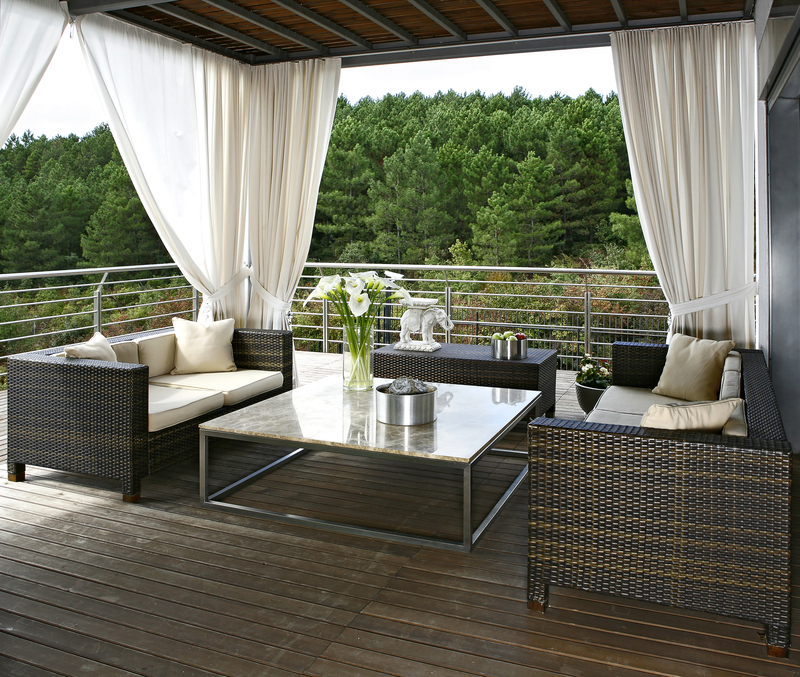Discover Vertical Gardening Innovations
Posted on 25/09/2025
Discover Vertical Gardening Innovations: The Future of Space-Efficient Greenery
Vertical gardening has blossomed from a niche hobby to a full-fledged movement among urban homeowners, eco-conscious gardeners, and city planners alike. As land becomes scarce and cities become denser, vertical gardening innovations offer creative solutions for growing lush, healthy plants in limited spaces. If you've ever wondered how to turn a bare wall into a leafy paradise or maximize your garden's yield in just a few square feet, you're in the right place. This article will guide you through the fascinating world of modern vertical gardens, the technologies powering this green revolution, the benefits and challenges, and how you can implement these cutting-edge ideas at home.

What Is Vertical Gardening?
Vertical gardening is the technique of cultivating plants on surfaces that are vertical instead of traditional horizontal beds. This can range from simple wall-mounted planters in residential settings to living walls--also called green walls--on skyscrapers. The roots of vertical gardening can be traced back to the Babilonian Hanging Gardens, yet modern technology has taken the concept to unprecedented heights.
Why Embrace Vertical Gardening?
- Maximizes Space: Perfect for small apartments, balconies, and urban homes with limited ground area.
- Improves Air Quality: Plants act as natural air purifiers, making your indoor or outdoor environment healthier.
- Energy Efficiency: Living walls act as insulation, reducing energy costs in both summer and winter.
- Enhanced Aesthetics: Transform bland fences and walls into lush, living masterpieces.
- Higher Yields: With vertical stacking, you can grow more plants per square foot.
Innovative Vertical Gardening Systems
The last decade has seen vertical gardening systems evolve rapidly thanks to design ingenuity and advancements in materials and automation. Let's explore the most exciting types and how each revolutionizes space-efficient gardening.
Living Walls (Green Walls)
Living walls, also referred to as green walls, are striking, large-scale installations that attach directly to indoor or outdoor surfaces. They typically consist of modular panels filled with soil or a soil-less growing medium and are irrigated via integrated systems.
- Hydroponic Panels: Grow plants without soil, utilizing a mineral solution and water-efficient recirculation systems. These panels are lightweight and ideal for high-rise applications.
- Felt Pocket Walls: Use industrial felt to create pockets where plant roots thrive. These lightweight, flexible systems are well-suited for residential and commercial spaces alike.
- Eco-friendly Modular Blocks: Made from recycled materials, these blocks are easy to assemble and disassemble while providing robust support for plant roots.
Vertical Tower Gardens
Vertical towers are cylindrical, multi-level planters that enable homeowners and urban farmers to grow dozens of plants in a small footprint. These systems are technologically innovative, offering features such as:
- Aeroponic growing: Roots are suspended in the air and misted with nutrients, using up to 90% less water than traditional gardens.
- Self-watering systems: Automated pumps circulate water and nutrients, making gardening nearly effortless.
- LED Grow Lights: Some towers come equipped with energy-efficient lighting for constant growth regardless of sunlight availability.
Green Facades and Trellis Systems
Another form of space-saving gardening is the use of green facades, where climbing plants or vines grow up wire systems, trellises, or architectural frames. This not only beautifies facades but also provides shade and cools the building naturally.
- Cabled trellises: Sleek stainless steel cables enable plants to climb naturally, suitable for both public and private projects.
- Custom frames: Architects now design custom trellis structures that integrate seamlessly with building exteriors.
Breakthroughs in Vertical Gardening Technology
As the demand for vertical gardening innovation grows, research and technology lead the charge to greater efficiency and sustainability. Here's how smart solutions are changing the landscape of vertical gardening:
Smart Sensors and IoT Integration
- Remote Monitoring: Sensors track moisture, pH, light levels, and temperature, providing real-time feedback to gardeners' smartphones.
- Automated Adjustments: When paired with apps or smart home systems, these sensors can trigger irrigation, adjust lighting, or regulate nutrient delivery, optimizing plant health even when gardeners are away.
- Data Analysis: Over time, these systems analyze patterns, providing tailored recommendations for each plant species.
Sustainable Water Management
- Recirculating irrigation: Closed-loop watering systems save water by recycling it through the vertical garden, reducing waste dramatically.
- Rainwater harvesting: Advanced setups channel rainwater directly into the irrigation system, making vertical gardens compatible with eco-friendly urban planning.
Advanced Growing Mediums
- Soilless Substrates: New materials like coir, rockwool, and expanded clay pellets provide superior aeration, moisture retention, and structural support for plant roots.
- Bioactive layers: Some vertical gardens incorporate microbial-rich layers that actively break down pollutants, purifying both soil and air.
Energy-Efficient LED Grow Lights
One of the key vertical gardening advancements is the development of tailor-made LED grow lights which mimic sunlight and allow year-round cultivation--even indoors or in low-light urban environments. These lights are energy efficient, customizable by plant type, and can be automated to sync with day-night cycles.
Creative Design Inspirations
Thinking beyond utility, vertical gardens have become canvases for creative expression. Here are some inspiring ideas to revolutionize your space with vertical gardening:
- Edible Walls: Create a vertical vegetable garden in your kitchen or patio using herbs, leafy greens, cherry tomatoes, and strawberries.
- Flowering Living Art: Arrange colorful annuals and perennials in geometric patterns to create living wall murals.
- Moss Walls: Low-maintenance, striking installations often used indoors for noise reduction and humidity control.
- Succulent Panels: Drought-resistant succulents are perfect for sculptural, low-water vertical gardens.
- Biodiversity Columns: Combine ornamentals, edibles, and even pollinator-friendly plants in vertical stacks to foster urban biodiversity.
Benefits of Cutting-Edge Vertical Gardening
Vertical gardens do much more than just save space. Here's a comprehensive overview of the major benefits brought by modern vertical gardening technologies:
- Health & Wellness: Improved air quality and increased green space contribute significantly to mental health and lower urban stress levels.
- Urban Agriculture: Boosts food security by allowing city dwellers to grow fresh, organic produce right at home.
- Climate Impact: Living walls act as natural insulators and carbon sinks, reducing heating/cooling costs and trapping pollutants.
- Noise Reduction: Dense plantings absorb sound, making them ideal for offices, schools, and city environments.
- Property Value: Attractive vertical gardens significantly enhance the aesthetic value and market appeal of homes and businesses.
Challenges and Solutions in Vertical Gardening
Despite its tremendous promise, vertical gardening comes with its own set of challenges. Let's look at common issues and how today's vertical gardening innovations address them:
- Water Management: Without efficient irrigation, water can quickly pool or dry out. Solution: Automated, drip-based systems ensure consistent moisture with minimal wastage.
- Structural Concerns: Living walls can be heavy. Solution: Lightweight modular panels and hydroponic techniques significantly reduce weight, making installations viable on many existing walls.
- Pest Control: Dense planting can attract insects. Solution: Integrated pest management using beneficial insects and organic sprays.
- Maintenance: High, complex gardens are harder to tend. Solution: Modular systems offer easy access; remote monitoring alerts to issues before they become problems.
How to Start Your Own Innovative Vertical Garden
Are you inspired to embark on your own vertical gardening journey? Here's a step-by-step guide to help you get started with the latest techniques and technologies:
1. Assess Your Space
- Identify vertical surfaces (walls, fences, balconies) with adequate sunlight or install LED lighting for shaded locations.
- Ensure wall structures can support the weight of your desired system.
2. Choose the Right Vertical Gardening System
- For beginners, start with DIY pocket planters or modular wall kits available at garden centers.
- For tech enthusiasts, consider a hydroponic or aeroponic tower garden with app-connected controls.
3. Select Suitable Plants
- Pick varieties that thrive in your climate and the available light conditions--leafy greens, herbs, and succulents are generally easy choices.
- Mix edible, ornamental, and pollinator-friendly plants for a vibrant, productive vertical garden design.
4. Install Smart Systems
- Add sensors, smart timers, and self-watering systems for hassle-free maintenance and consistent plant health.
- Integrate rainwater harvesting for maximum sustainability.
5. Maintain and Innovate
- Monitor plant health through your smart devices and adapt as needed.
- Experiment with new plants, lighting, and modular setups to keep your vertical garden thriving and exciting.

The Future of Vertical Gardening: Trends to Watch
The field of vertical gardening continues to evolve rapidly. Here are some emerging trends that promise to shape the future:
- AI-powered Growth Optimization: Machine learning analyzes data from vertical gardens and suggests ideal planting and care strategies.
- Biophilic Design: Incorporating nature-inspired elements into offices and public spaces for health and productivity gains.
- Urban Agriculture Integration: Major cities are adding vertical farms to rooftops, facades, and unused lots, transforming local food systems.
- 3D Printed Plant Modules: Custom-designed, sustainable modules allow for ultra-efficient use of urban vertical spaces.
Conclusion: Embrace the Possibilities of Vertical Gardening Innovations
In a world where space and resources are increasingly precious, vertical gardening innovations offer a sustainable, beautiful, and practical way to reconnect with nature--whether you're a city dweller looking to green your apartment or a business hoping to enhance your building's ecology and appeal. With technologies like smart sensors, energy-efficient lighting, and innovative design, the possibilities are truly endless. Don't wait--start your own vertical gardening adventure today and become part of the movement that's transforming urban environments one wall at a time!

